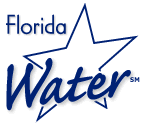Nov. 18, 2009
The St. Johns River Water Management District introduced a new tier in its Florida Water Star℠ program to provide existing homeowners water conserving opportunities. The new “Bronze” tier was developed with input from a large stakeholder group from around the state. Where the Silver and Gold tiers successfully work with builders of new homes to conserve water, the Bronze tier was developed to certify homeowners’ efforts to retrofit their existing homes for water efficiency.
Nov. 10, 2009
The District’s Governing Board voted to purchase a 3,321-acre property mostly within the Volusia Conservation Corridor Florida Forever Project boundary that offers the potential for long-term water storage benefits and expansion of the conservation corridor. The property, known as the Maytown tract, is located south of Lake Ashby along State Road 415 and Maytown Road.
Nov. 10, 2009
In a unanimous vote, the St. Johns River Water Management District’s Governing Board re-elected Susan N. Hughes of Ponte Vedra Beach to serve as Board chairwoman. The Board also re-elected W. Leonard Wood of Fernandina Beach as vice chairman, Hersey “Herky” Huffman of Enterprise as secretary, and Hans G. Tanzler III of Jacksonville as treasurer.
Sept. 8, 2009
The District’s Governing Board approved a land exchange agreement that completes the corridor for the Econ-St. Johns Ecosystem Florida Forever Project and completes the protection of approximately 80,000 acres of public conservation land. The exchange also resulted in the protection of the final 1.5 miles of privately owned riverfront and marshlands in the area, and the connection of the Florida National Scenic Trail.
Aug. 3, 2009
Florida Water Star℠ was expanded to include a new Gold tier that provides an even higher standard for water efficiency in the home than the existing Silver tier.
July 20, 2009
Following the passage of Senate Bill 2080, the District announced it would hold public meetings to ensure that the public continued to have opportunities to provide “in person” input into the District’s permitting process.
July 1, 2009
Senate Bill 2080 became law, amending Chapter 373,
Florida Statutes, and changing the process in which water resource permits are approved by the state’s five water management districts. The new law directed the governing boards of the water management districts to delegate their authority to approve permits to their executive directors.
June 30, 2009
U.S. Commerce Secretary Gary Locke announced that the St. Johns River Water Management District will receive $2.7 million for community-based coastal restoration projects in Brevard and Volusia counties. Under the American Recovery and Reinvestment Act of 2009, the Commerce Department’s National Oceanic and Atmospheric Administration was provided $167 million for marine and coastal habitat restoration. The District was among 50 recipients awarded a portion of the funds for projects across the nation. Of the $2.7 million the District will receive, $1.6 million will be used to restore 30 acres of dredge spoil-filled historic saltmarsh at the North Peninsula State Park in Volusia County. The remaining $1.1 million will be used to restore impounded coastal wetlands at Merritt Island National Wildlife Refuge by the scraping down of at least 12 miles of impoundment dike.
May 19, 2009
The District’s Florida Water Star℠ program received national recognition as a result of Hardwick General Contracting (HGC) Inc. being awarded the 2009 National Association of Home Builders (NAHB) Green Building Award. HGC won in the NAHB Green Remodeling—Project of the Year category for Amherst Place in the College Park neighborhood of Orlando. Amherst Place is a combination of two single-family residences, and the combined two-unit duplex was the first in Orlando to achieve Florida Water Star℠, Green building and Energy Star certifications.
March 10, 2009
In recognition of the increasing importance of potable water projects to meet future demands, the St. Johns River Water Management District’s Governing Board increased its financial support of the development of a regional saltwater desalination facility in Flagler County. The Board allocated $9.8 million in additional funds to the project, bringing the District’s total contribution to approximately $17 million. The District is partnering with several water utilities to investigate and prepare preliminary design documents for a desalination facility in the greater Flagler County area — a region known as the Coquina Coast. The partners in the agreement are the District; the Water Authority of Volusia; Flagler, Marion and St. Johns counties; Dunes Community Development District; and the cities of Palm Coast, DeLand, Mount Dora; and the towns of Leesburg, Bunnell and Flagler Beach.

March 8, 2009
New watering restrictions for landscape irrigation became effective across the 18 counties of the St. Johns River Water Management District. Under the new restrictions, landscape irrigation days are specified and is limited to two days a week during daylight saving time and one day a week during Eastern Standard Time. The restrictions apply to water withdrawn from ground or surface water, from a private well or pump, or from a public or private water utility, but they do not apply to irrigation using reclaimed water or storm water. See more about the restrictions.
Feb. 11, 2009
The St. Johns River Water Management District’s Governing Board approved funding for projects to reduce excessive nitrogen entering the lower St. Johns River and to increase reclaimed water use. The funding will help communities phase out wastewater discharges to instead treat and divert wastewater to be used as reclaimed water. The funding raises the amount authorized by the District since 2006 for lower basin reuse and wastewater treatment plant projects to $53.8 million.
Feb. 11, 2009
The contributions of Linda Goode, an educator for the St. Johns River Water Management District’s Indian River Lagoon Program, were recognized with the dedication of a new exhibit at the Brevard Zoo in her honor. Linda’s Learning Lagoon is part of a new exhibit — Paws On: Build, Explore, Splash, Touch. The District contributed about $150,000 for educational elements and programming, and interpretive signs for the exhibit, as part of the District’s work to enhance the public’s understanding of the importance and significance of the lagoon.
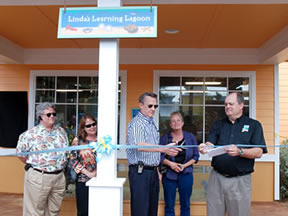
Jan. 16, 2009
The St. Johns River Water Management District released an interim draft report on the St. Johns River. The study’s goal is to provide an objective, comprehensive, and scientifically rigorous analysis of the potential environmental effects of river withdrawals. The results of the study will be used to guide permitting decisions that will determine whether, and to what extent, the river’s waters can be used to supplement groundwater supplies to help meet future water needs.
Dec. 9, 2008
The District’s Governing Board adopted rule amendments that will tighten the District’s irrigation restrictions. When the amendments become effective on March 8, 2009, landscape irrigation will be limited to two days a week during daylight saving time (warmer months of the year) and one day a week during Eastern Standard Time (the cooler months of the year). The amended rule also sets the days of the week that residential and non-residential users can irrigate. As with the previous rule, irrigation is not allowed between 10 a.m. and 4 p.m.
Nov. 11, 2008
The District’s Governing Board approved $1.25 million for four cities to develop stormwater projects and $5.2 million to assist local government utility partners with wastewater treatment plant upgrades in the Lower St. Johns River Basin. Partners selected for stormwater cost-share funding were the cities of Ocala, Jacksonville Beach, St. Augustine and Palm Bay. Receiving legislative funds for treatment plant upgrades were Jacksonville, Jacksonville Beach, Neptune Beach and Atlantic Beach. The stormwater projects are designed to improve water quality in water bodies in north and east-central Florida by treating or removing pollutants from storm water. In some cases, the projects will also reduce recurring flooding. The funding for wastewater projects will help the recipients reduce the amount of nutrients reaching the St. Johns River to a level lower than required by a new state water quality standards for the river.
Oct. 14, 2008
Australia’s International Riverfoundation, a river advocacy organization, awarded the St. Johns River Water Management District the Thiess Riverprize — the world’s largest award in its field — for its role in restoring the Upper St. Johns River Basin (the headwaters of the 310-mile-long St. Johns River). The 247-square-mile Upper St. Johns River Basin Project is one of the most ambitious wetland restoration projects of its kind in the world. The project is co-sponsored by the District and the U.S. Army Corps of Engineers. Judges chose the Upper Basin Project over two other outstanding international finalists — Lake Macquarie in New South Wales and the Swan Canning River System in western Australia.
Oct. 6, 2008
The St. Johns River Water Management District executed a contract with the National Research Council of the prestigious National Academies to provide peer review of its assessment of potential cumulative impacts to the St. Johns River from proposed surface water withdrawals. The National Research Council, headquartered in Washington, D.C., is the research arm of the National Academies and is one of four organizations making up the National Academies, which serve as advisors to the nation on science, engineering and medicine. Under the contract executed on Oct. 1, National Research Council peer review experts will be engaged at key intermediate points throughout the life of the project, providing the District’s research team with a high level of understanding of the project and the District’s analyses of the potential environmental effects. The District’s research team includes dozens of District scientists and engineers and 13 outside experts of national scientific stature.
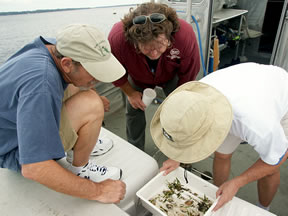
Sept. 23, 2008
The St. Johns River Water Management District’s Governing Board adopted its fiscal year 2008–2009 budget, retaining the agency’s tax rate at 0.4158 mills for the fiscal year that begins Oct. 1. The Board also gave final approval to the $375.7 million budget, which represents a $69.8 million decrease from the current budget. The decrease is attributed to reductions in ad valorem revenues, as well as a 39.3 percent reduction in new state revenues.
Sept. 17-18, 2008
To decrease the likelihood of flooding along the St. Johns River system in Indian River and Brevard counties, the St. Johns River Water Management District began releasing water through Canal 54 into the St. Sebastian River — a tributary of the Indian River Lagoon. The discharge of water through the canal that runs between the two counties was done to lower water levels in the rain-soaked upper basin of the St. Johns River as a result of the historic rainfall totals produced by Tropical Storm Fay earlier in the month.

Aug. 24, 2008
To decrease the likelihood of flooding along the St. Johns River system in Indian River and Brevard counties, the St. Johns River Water Management District began releasing water through Canal 54 into the St. Sebastian River — a tributary of the Indian River Lagoon. The discharge of water through the canal that runs between the two counties was done to lower water levels in the rain-soaked upper basin of the St. Johns River as a result of the historic rainfall totals produced by Tropical Storm Fay earlier in the month.
Aug. 22, 2008
A new economic study has concluded that the Indian River Lagoon provided an estimated $3.7 billion in benefits in 2007 to residents and visitors of the five counties in the lagoon watershed. The study examined the recreational, environmental, real estate, restoration and commercial fishing benefits of the 156-mile-long estuary that flows through Volusia, Brevard, Indian River, St. Lucie and Martin counties. This was the first economic study of the lagoon since 1995, when the lagoon’s value was estimated at $730 million annually.
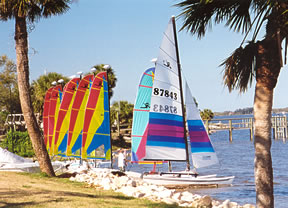
June 23, 2008
The St. Johns River Water Management District launched a “really simple syndication” (RSS) subscription service designed to allow the public to review current notifications of the posting of certain information on the District’s website. The RSS subscription service, which is free, allows for frequently updated website content to be listed in an abbreviated and organized form that is easily read through the use of RSS readers, web browsers, and desktop-based email software. Initial feeds will be limited to news releases, and may be expanded in the future to include other website content notices and updates.
May 27, 2008
Construction began on an extensive new water management project in the headwaters of the St. Johns River in Indian River County. Project work will convert 10,000 acres of agricultural land to a mosaic of open water and marsh communities. Located just east of the St. Johns River Water Management Area — known by local anglers as the Stick Marsh — the Fellsmere Water Management Area (FWMA) will provide additional water supply, flood protection, water quality, recreational and habitat restoration benefits in the Upper St. Johns River Basin. FWMA will be completed in several phases. The entire project is scheduled to be completed and open for recreation in 2016. The St. Johns River Water Management District has undertaken this project in partnership with the Wetland Reserve Program of the U.S. Natural Resources Conservation Service.
March 11, 2008
The St. Johns River Water Management District launched a new multimedia campaign to heighten awareness of the importance of water conservation and to provide tips on how to conserve. With the projected population increases expected in the District, meeting future water supply demands will be a challenge. While meeting these demands will require a number of strategies, the District considers water conservation to be the foundation of all water supply planning efforts.
Feb. 6, 2008
Florida Water Star℠ and Green Builder® Media debuted a model home at Lake Apopka that showcases the environmental and economic benefits of water-efficient homes. The 2008 Green Builder® Orlando House features the extensive use of renewable energy sources and high-efficiency components. The house uses cisterns to collect stormwater runoff and super efficient Kohler fixtures in the home to conserve water. The landscaping utilizes native and nonnative site-appropriate plantings that will decrease the need for supplemental irrigation except in extreme droughts. District staff were on hand to certify the VISION House as fulfilling Florida Water Star℠ standards. New homes are certified by meeting criteria that demonstrate water efficient landscape design, irrigation and indoor water savings.
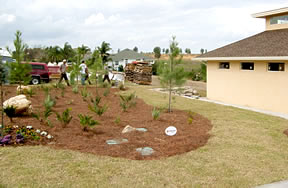
Workers put the finishing touches on the landscape of the Vision House at Lake Apopka. The home was certified as meeting Florida Water Star℠ criteria.
January/February, 2008
Dozens of schools across northeast and east-central Florida held “Splash into Science Night” events sponsored by the St. Johns River Water Management District and its Watershed Action Volunteer Program. The Science Night events are hands-on, interactive family events focusing on the importance of Florida’s water resources. Activities typically include conducting water experiments, and making water cycle wristbands, an “edible aquifer” and “fish print” T-shirts. In the process, students learn about groundwater and how to reduce stormwater pollution from entering local waterways.
Nov. 26, 2007
The St. Johns River Water Management District’s Minimum Flows and Levels (MFLs) Program won a Technical Excellence Award in recognition of outstanding research in lake restoration, protection and management from the North American Lake Management Society (NALMS) during its 27th annual symposium. Establishing MFLs is an important step in the District’s work of planning for adequate water supplies for today and for future generations while also protecting water resources from significant harm. MFLs are set to prevent significant harm from water withdrawals.

Nov. 26, 2007
Two St. Johns River Water Management District programs developed to inform the public about the importance of water conservation garnered top honors at the fall conference of the Florida chapter of the American Water Works Association. The District received Awards of Excellence, “Best in Class,” Nov. 14 for its Water Conservation Public Awareness Campaign and its new Florida Water Star℠ program.
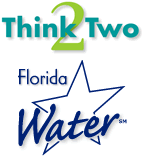
Nov. 5, 2007
 The St. Johns River Water Management District launched pages on its website dedicated to educating and informing the public about proposed withdrawals from the St. Johns and Ocklawaha rivers. In some areas of the District, traditional groundwater supplies used for drinking and household uses have reached sustainable limits. The District is mandated to identify potential water sources and to investigate if and to what extent alternative water supply sources — such as river and seawater, brackish groundwater and reclaimed water — can be developed and used without causing harm to the environment. The web pages offer facts about the mandates of state law that have led to the discussion, information about District programs investigating the feasibility of surface water withdrawal proposals, and responses to frequently asked questions.
The St. Johns River Water Management District launched pages on its website dedicated to educating and informing the public about proposed withdrawals from the St. Johns and Ocklawaha rivers. In some areas of the District, traditional groundwater supplies used for drinking and household uses have reached sustainable limits. The District is mandated to identify potential water sources and to investigate if and to what extent alternative water supply sources — such as river and seawater, brackish groundwater and reclaimed water — can be developed and used without causing harm to the environment. The web pages offer facts about the mandates of state law that have led to the discussion, information about District programs investigating the feasibility of surface water withdrawal proposals, and responses to frequently asked questions.
Oct. 1, 2007
The District’s new website was officially launched after more than a year of revisions. New features include the expanded use of video and animation technology, answers to frequently asked questions and an improved site map/topic index. Also, the new site is formatted in compliance with the Americans with Disabilities Act to accommodate computer settings used by the visually impaired. The dynamic design allows postings of important and time-sensitive information directly on the home page, with links to supporting documents. Likewise, the home page will give visitors a glimpse into the daily workings of the District through feature articles and photographs that explain the work of individuals. The District’s website was first launched in late 1996 and has grown to several thousand pages, with more than 40,000 file attachments and nine special application sites.
Sept. 26, 2007
The Indian River Lagoon’s Citizens Action Committee (CAC) and Technical Advisory Committee (TAC) held a joint meeting to review proposed updates and revisions to the Indian River Lagoon Comprehensive Conservation and Management Plan (CCMP).
Developed by a consortium of residents from along the lagoon, state and federal agencies and local governments, the CCMP was approved in 1996 by the U.S. Environmental Protection Agency (EPA) and Florida’s governor as a blueprint for protecting and restoring the lagoon. Under this plan, achievements have included more than $75 million in water quality improvement projects, ongoing wetlands and shoreline restoration and enhancement, and promotion of the acquisition of priority environmentally endangered lands along the lagoon.
In recent years, new challenges and issues in the lagoon have arisen that are not currently addressed in the management plan. “It is time to revise and update this document to reflect not only the progress made, but to include and address emerging issues,” said Robert Day, a lagoon biologist for the St. Johns River Water Management District.
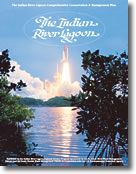
Aug. 29, 2007
Scientists with the St. Johns River Water Management District have been monitoring algal blooms in the lower basin of the St. Johns River in Clay, Duval, Putnam and St. Johns counties. District staff regularly monitor algal growth in the river and routinely collect water and algae samples. When an algal bloom is observed, additional tests are conducted to determine if any algal toxins are present. As of today, the predominant algae in the river between Doctors Lake and downtown Jacksonville has been Anabaena circinalis, a nuisance blue green algae. While some strains can produce algal toxins, those found in Florida are not associated with algal toxin production but can increase the river’s nutrient (nitrogen) problems. District scientists say that while the 2.48 parts per billion (ppb) concentration for microcystin near Doctors Inlet is the highest concentration staff have observed this year, it is still well below World Health Organization (WHO) guidelines, for which its first stage warning level is 4 ppb.
Aug. 7, 2007
Thirty-four alternative water supply construction projects were approved for $29.03 million in cost-share funding today by the St. Johns River Water Management District’s Governing Board. Cost-share funding for these projects comes from the Florida Water Protection and Sustainability Program (WPSP). The projects, located in Flagler, Putnam, Volusia, St. Johns, Orange, Lake, Seminole, Brevard and Osceola counties, are designed to develop surface water or brackish groundwater, or increase the use of reclaimed water.
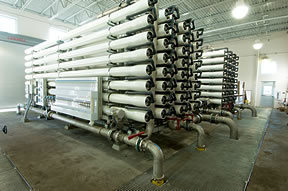
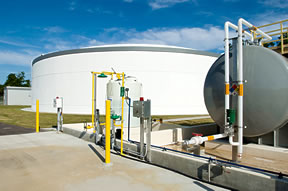
July 10, 2007
The St. Johns River Water Management District’s Governing Board voted today to reduce the agency’s tax rate to 0.4158 mills for the 2007–2008 fiscal year, which begins Oct. 1. In Florida’s June special session, the Legislature enacted legislation to reduce property taxes beginning with the upcoming fiscal year. The bill sets the maximum millage rate for water management districts at 97 percent of the 2007–2008 rolled-back rate. The rolled-back rate is defined as the rate at which tax dollars will provide the same ad valorem tax revenue as the prior year, minus new construction, additions to structures, deletions, and property added due to geographic boundary changes. To support the new limits, the District will reduce its millage from 0.462 in fiscal year 2006–2007 to 0.4158 next year. As a result, the District will reduce its allocation for new initiatives and projects by approximately $15 million.
June 22, 2007
The St. Johns River Water Management District and Beazer Homes today signed an agreement that will earn the new Durbin Crossing North subdivision the distinction of being the first Florida Water Star℠ community in St. Johns County. Beazer has committed to build 100 new homes that meet Florida Water Star℠ standards in the subdivision and other areas of St. Johns County. “Water is a resource we all share, and as Florida’s population increases, so does the need for all of Florida’s residents to conserve water,” said Linda Burnette, director of the District’s Office of Communications and Governmental Affairs, at an event marking the occasion. “Beazer is proud to be among the first builders to offer the Florida Water Star℠ program,” said Barbara Moore, president of Beazer Homes’ Jacksonville Division. “Water Star℠ complements the Energy Star homes Beazer is already offering, and complements our commitment to be a green builder.”
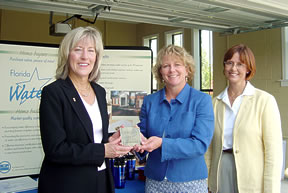
Linda Burnette, communications director for the District, center, presents Beazer Homes officials with a plague designating this model home as achieving Florida Water Star℠ certification.
Spring 2007
The Harris Bayou project is now under construction. This project will restore wetland systems and improve flood control in the Upper Ocklawaha River Basin and improve the way lake levels are managed. The District and the Florida Department of Transportation have partnered to install a culvert system needed to connect lakes Harris and Griffin.
April 20, 2007
The Paradise Key model home in Jacksonville Beach is the first Florida Water Star℠-certified home in Duval County’s beaches cities. Florida Water Star℠ is a point-based new-home certification program encouraging water efficiency in household appliances, plumbing fixtures, irrigation systems and landscapes. The program promotes the economic and environmental benefits of efficiency in new home construction by offering resources and incentives to builders and home buyers who participate.
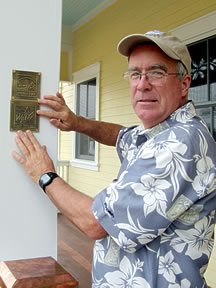
Developers are now building certified Florida Water Star℠ homes.
April 16, 2007
The District launches the Lower St. Johns River Basin public awareness initiative, “The St. Johns: It’s Your River.” The campaign’s purpose is to educate the public about how human behaviors impact the river and how negative behaviors can be changed. District public awareness research showed that many people living in northeast Florida feel a sentimental connection to the St. Johns River but that emotional connection does not extend to an understanding of their personal impacts to the river or their responsibility for the river’s condition. The campaign’s theme is intended to move individuals to feel a personal connection to the river and to take personal responsibility for the river’s health.
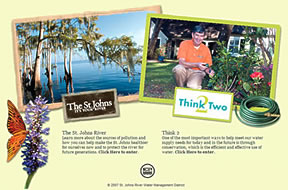
March 2007
The District launches its annual Water Conservation Public Awareness Campaign, again using the theme “Think Two.” This year’s campaign emphasizes that lawns can be healthy when watered (or receiving rain) no more than two days each week and encourages viewers to properly maintain sprinkler systems.
Feb. 13, 2007
As part of its work to restore and protect the Lower St. Johns River Basin, the District’s Governing Board voted to buy 281 acres of farmland in southwest St. Johns County for a regional stormwater project to receive and help treat storm water from 1,782 acres of land. Regional stormwater treatment projects help reduce the amounts of phosphorus, nitrogen and suspended solids from agricultural operations flowing into the river.
Jan. 29, 2007
The U.S. Army Corps of Engineers announced that $12 million in funding was available to complete the Three Forks Marsh Conservation Area, a major water management feature of the Upper St. Johns River Basin Project in south Brevard County. Three Forks, the last major component of the upper basin project, is slated to be completed by 2010.
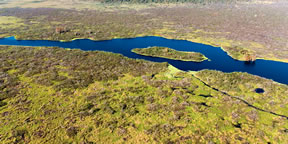
An aerial view of the St. Johns River as it flows through the Three Forks Marsh Conservation Area.
January 2007
The District partners with the state of Florida, Orange and Lake counties, and the Orlando-Orange County Expressway Authority to purchase the Neighborhood Lakes property in Orange and Lake counties. The purchase of the 1,584 acres enlarges the conservation corridor from the Wekiwa Springs State Park and Rock Springs Run State Reserve to the Ocala National Forest.
Dec. 15, 2006
Officials participated in a ribbon-cutting ceremony to kick off the start of the Crane Creek dredging project in downtown Melbourne. The District, state of Florida, city of Melbourne, and Florida Inland Navigation District (FIND) joined the dredging project that was expected to remove approximately 110,000 cubic yards — roughly 6,100 dump truck loads — of sand and muck from the creek. The two-year endeavor was estimated to cost $1.3 million with funding being provided by the state, the District, FIND, the city of Melbourne and sales of the Indian River Lagoon license plate.
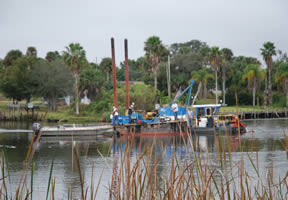
A dredging crew removes silt, clay and other organic material known as — muck — from Crane Creek.
Dec. 8, 2006
The District hosted an event to mark the completion of the Sebastian Stormwater Park. The 167-acre park essentially filters pollutants from the Collier Canal, which captures stormwater runoff from the Sebastian watershed. Water flows through a series of four treatment ponds of varying sizes constructed at the park. Sediments and suspended solids will settle out to the bottom of the ponds, the largest and final pond in the chain being a 60-acre historical wetland surrounded by a berm. The treated water will then return to Collier Creek and, ultimately, to the Indian River Lagoon.
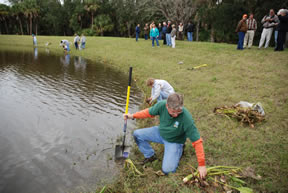
Volunteers plant wetlands vegetation around a stormwater treatment pond in the city of Sebastian to filter pollutants from storm water.
Nov. 7, 2006
Four county governments and nine towns and cities will share more than $4 million in District cost-share funds to develop 16 stormwater projects. The projects will improve water quality in water bodies in central and east-central Florida and, in some cases, reduce recurrent flooding. Partners selected for cost-share funding were the cities of South Daytona, Winter Park, Cocoa, Eustis, Flagler Beach, Cape Canaveral, Leesburg, Green Cove Springs, and Ormond Beach; and Marion, Volusia, Flagler and Brevard counties. Since the initiation of the Stormwater Management Projects Cooperative Cost-Sharing Program in 1995, the District has provided $8.02 million to cost-share 163 stormwater management projects with local governments.
Nov. 7, 2006
In a unanimous vote, the District’s Governing Board agreed to retain its current slate of officers, re-electing David G. Graham of Jacksonville as chairman; John Sowinski of Orlando as vice chairman, Ann T. Moore of Bunnell as secretary, and Duane L. Ottenstroer of Jacksonville as treasurer.
Nov. 7, 2006
The Governing Board unanimously approved a land exchange with the Goodman Co. that will preserve the sensitive wetlands of the Freedom Commerce Centre property in Duval County. The Freedom Commerce Centre, located at U.S. 1, Baymeadows Road and Interstate 95, contains wetlands that are the headwaters for Julington and Pottsburg creeks, which both ultimately flow into the St. Johns River.
The Board also approved a permit modification that will limit wetland impacts at the Freedom Commerce Centre to 29 acres, down from 127 acres of wetlands that could have been developed under an environmental resource permit and mitigation plan approved in September 2005.
October 2006
The District’s Governing Board approved a minimum flow regime, which increases incrementally over time, for Blue Spring in Volusia County. The minimum flow regime will protect the use of Blue Spring as a winter warmwater refuge for the West Indian manatee population and will support the protection of all relevant water resource values. The Governing Board also approved an action plan to ensure the required flows will be achieved by the dates established in the regime.

A manatee
Fall 2006
The St. Johns River Water Management District partnered with the Orange County Department of Health (DOH) and the Florida Department of Agriculture and Consumer Services (DACS) to address an infestation of mice in the Lake Apopka area. To lessen potential habitat for mice in the North Shore Restoration Area, the District intensified its routine maintenance in the area, mowing and rollerchopping the former farm fields. In addition, the District tripled the number of barn owl nests throughout the restoration area from seven to 21. Barn owls are well known for controlling mouse populations in agricultural environments.
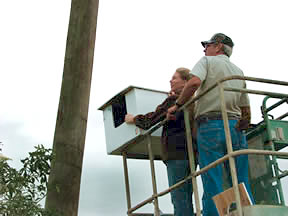
Two District employees install an owl box on a telephone pole in the North Shore Restoration Area at Lake Apopka. Owls build nests in the boxes and live off the rodent population in the area.
October 2006
The District’s Governing Board approved an addendum to the 2005 District Water Supply Plan to revise information directly linked to the water supply entity notification process, which is required pursuant to Section 373.0361,
Florida Statutes ; required for the District’s Water Protection and Sustainability Program; and essential in the District’s efforts to develop technical assistance documents for local governments to use in updating their comprehensive plans to address water supply issues.
Sept. 12, 2006
The Governing Board approved $33.9 million in funding to assist northeast Florida’s local governments with efforts to halt pollutant discharges to the lower St. Johns River and to expand the use of reclaimed water. The Board’s action provides funding assistance for 20 short-term projects, to be implemented within three years, to reuse treated wastewater or to more thoroughly treat wastewater that is currently being discharged to the river. When implemented, the projects will remove 1.8 million pounds of nitrogen from the river each year and remove 28 million gallons of effluent each day — or 10 billion gallons per year. This funding is part of the District’s commitment to spend up to $150 million for reuse projects over the next decade in the river restoration partnership called the River Accord, involving local governments, utilities, the Florida Department of Environmental Protection (DEP) and other partners. Additional longer-term projects have been identified, and funding will be considered in coming years. Combined, the short-term and longer term projects are expected to reduce the amount of pollutants flowing into the river to a level that will be lower than the maximum set under a new water quality standard, known as a total maximum daily load (TMDL), making it possible to cap a nutrient pollution level that has been steadily rising over time.
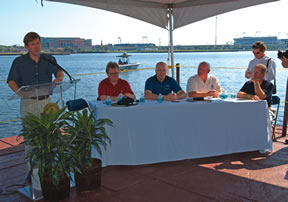
Jacksonville Mayor John Peyton, left, speaks during a ceremony to launch The River Accord, a St. Johns River cleanup partnership that includes the District. Kirby Green, District executive director, is seated third from left.
September 2006
The St. Johns River, South Florida and Southwest Florida water management districts begin development of an action plan to address water supply concerns in the Central Florida Coordination Area (CFCA), an area where the boundaries of the three Districts meet. This coordinated effort requires alternative water supply projects to be developed to meet allocation of groundwater beyond 2013 projected demands. The three Districts are conducting joint rulemaking to implement the necessary amendments to their respective consumptive use permitting rules and incorporating public comment into the process. The basis of the action plan is to expedite the development of alternative water supplies needed to supplement groundwater to meet the long-term water supply needs of the region.
September 2006
A dozen home building and landscape professionals became the state’s first Florida Water Star℠-certified inspectors, expanding their list of services while helping to make new homes and landscapes more water efficient. The new inspectors increase the program’s capacity to respond to builder and developer interests as technical advisors and by recommending Florida Water Star℠ certification.

Homes certified as meeting the criteria of the Florida Water Star℠ program are water-efficient outdoors and inside.
September 2006
The Legacy Water Resource Education Program — a St. Johns River Water Management District program that uses Florida’s public lands as classrooms and helps safeguard them for Florida’s future — has received two national awards from Take Pride in America, a national partnership established by the U.S. Department of the Interior.
Wilkinson Junior High School (Clay County, Fla.) Legacy teacher Karen Smith and the Dunnellon Middle School (Marion County, Fla.) Legacy’s Promoting Awesome Watershed Stewardship (PAWS) program will receive Take Pride in America National Awards at a ceremony in Washington, D.C., in September.
Smith received one of just five individual awards nationwide, in recognition of her outstanding contributions to education and Florida’s natural resources. With the assistance of fellow teacher Gayle May and District staff, Smith and students have designed, constructed and maintained miles of interpretive hiking trails, constructed and designed interpretive kiosks, and monitored the health of the river by performing annual inventories of its flora, fauna and water quality at J.P. Hall Conservation Area along the St. Johns River near Green Cove Springs. Dunnellon Middle School students were recognized as a youth group for their efforts at Rainbow Springs State Park in Marion County. Jointly sponsored by the St. Johns River and the Southwest Florida water management districts, PAWS has been active protecting the environment under the direction of teacher Sande Haynes. Fifteen schools in 11 counties use Legacy on 23 different tracts of public land, with 100 teachers and more than 2,500 students participating.
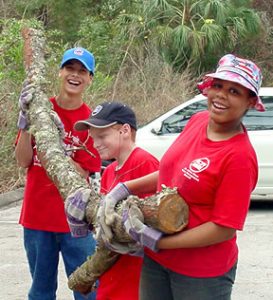
Members of the Dunnellon PAWS group participate in a clean up event following the 2004 hurricane season at Rainbow Springs State Park.
Aug. 8, 2006
Forty-six alternative water supply construction projects were approved for $45.4 million in cost-share funding by the St. Johns River Water Management District’s Governing Board. Cost-share funding for these projects comes from the Florida Water Protection and Sustainability Program (WPSP). The projects, located in Flagler, Putnam, Volusia, St. Johns, Marion, Orange, Lake, Seminole, Brevard and Osceola counties, are designed to develop surface water or brackish groundwater, or increase the use of reclaimed water.
July 13, 2006
A ribbon-cutting ceremony kicked-off the highly anticipated Sebastian River dredging project. Decades of stormwater runoff had blanketed much of the Sebastian River — an Indian River Lagoon tributary — with several feet of organic muck. This multiyear dredging project is designed to protect water quality and sea grass in the Sebastian River and the lagoon with the removal of up to two million cubic yards of muck, an amount equal to 200,000 dump truck loads. The organic material is being permanently deposited in a containment area on District land south of Micco Road.

Ashley Collins of Collins Builders
July 12, 2006
A ribbon-cutting ceremony kicked-off the highly anticipated Sebastian River dredging project. Decades of stormwater runoff had blanketed much of the Sebastian River — an Indian River Lagoon tributary — with several feet of organic muck. This multiyear dredging project is designed to protect water quality and sea grass in the Sebastian River and the lagoon with the removal of up to two million cubic yards of muck, an amount equal to 200,000 dump truck loads. The organic material is being permanently deposited in a containment area on District land south of Micco Road.
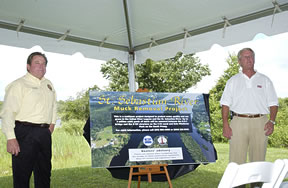
State Reps. Mitch Needleman and Stan Mayfield, from left, participated in a ceremony marking the beginning of dredging at the St. Sebastian River in July 2006.
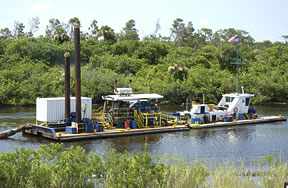
A dredging unit prepares to begin dredging at the St. Sebastian River in July 2006.
July 2006
 The St. Johns River Water Management District formalized a partnership with the city of Jacksonville, JEA and the Florida Department of Environmental Protection to improve the health of the St. Johns River’s lower basin. The partnership, called the River Accord, commits to investing $700 million over the next decade. Of this, the District will spend up to $150 million on reclaimed water and wastewater projects in Duval, St. Johns, Clay and Putnam counties, which will remove 1 million pounds of nitrogen per year and remove 28 million gallons per day — or 10 billion gallons per year — of discharge from the river by implementing beneficial wastewater reuse.
The St. Johns River Water Management District formalized a partnership with the city of Jacksonville, JEA and the Florida Department of Environmental Protection to improve the health of the St. Johns River’s lower basin. The partnership, called the River Accord, commits to investing $700 million over the next decade. Of this, the District will spend up to $150 million on reclaimed water and wastewater projects in Duval, St. Johns, Clay and Putnam counties, which will remove 1 million pounds of nitrogen per year and remove 28 million gallons per day — or 10 billion gallons per year — of discharge from the river by implementing beneficial wastewater reuse.
May 8, 2006
Scientists with the St. Johns River Water Management District are monitoring algal blooms in the lower St. Johns River in Putnam, Clay and St. Johns counties. District staff routinely monitor algal growth in the river and are collecting samples to determine if algal toxins are associated with current blooms. While the peak season for algae to proliferate is typically late summer to early fall, dry conditions appear to have triggered the recent algal bloom. Algal blooms are caused by a combination of hot, overcast days, calm wind and excessive nutrients in the water, such as fertilizer runoff, stormwater runoff and wastewater.
March 10, 2006
The Florida Institute of Technology hosted a symposium that revisits questions raised 25 years ago about human impacts on the Indian River Lagoon. During the original Florida Academy of Sciences symposium in 1981, natural resource managers, scientists and environmentalists took their first-ever comprehensive look at the lagoon ecosystem. The Indian River Lagoon National Estuary Program (sponsored by the St. Johns River Water Management District) staff participated in both the original and 2006 symposiums.
March 7, 2006
Thirty alternative water supply construction projects were approved for cost-sharing for $18.2 million by the St. Johns River Water Management District’s Governing Board. The cost-share funding for these projects comes from the Florida Water Protection and Sustainability Program (WPSP). The WPSP was created through passage of Senate bills 360 and 444 during the 2005 legislative session. The new legislation provides cost-share funding to encourage development of alternative water supply sources, such as surface water, brackish groundwater and reuse of reclaimed water.
March 1, 2006
The District’s amended lawn and landscape irrigation rule became effective. The amended rule allows irrigation no more than two days a week, before 10 a.m. or after 4 p.m.
February 2006
The District’s Governing Board approved the first five-year update to the 2000 District Water Supply Plan. The 2005 plan identifies water resource development projects and water supply development projects, which if implemented, should be more than adequate to meet water supply needs through 2025.
Jan. 25, 2006
Through the magic of cartoon animation and computer technology, fourth-graders can now experience a “time machine” and fifth-graders can determine if their make-believe hometown has enough water to build a water park. Eleven months after The Great Water OdysseySM was first introduced by the St. Johns River Water Management District, fourth- and fifth-graders in northeast Florida launched the Odyssey’s new adventures.

Jan. 19, 2006
The St. Johns River Water Management District formally unveiled Florida Water StarSM, a point-based new-home certification program, and is pilot-testing the program with northeast Florida builders. Similar to the federal Energy Star program, but with a water conservation focus, Florida Water StarSMencourages water efficiency in household appliances, plumbing fixtures, irrigation systems and landscapes. The program promotes the economic and environmental benefits of efficiency in new home construction by offering resources and incentives to builders and homebuyers who value water efficiency in new home construction.
